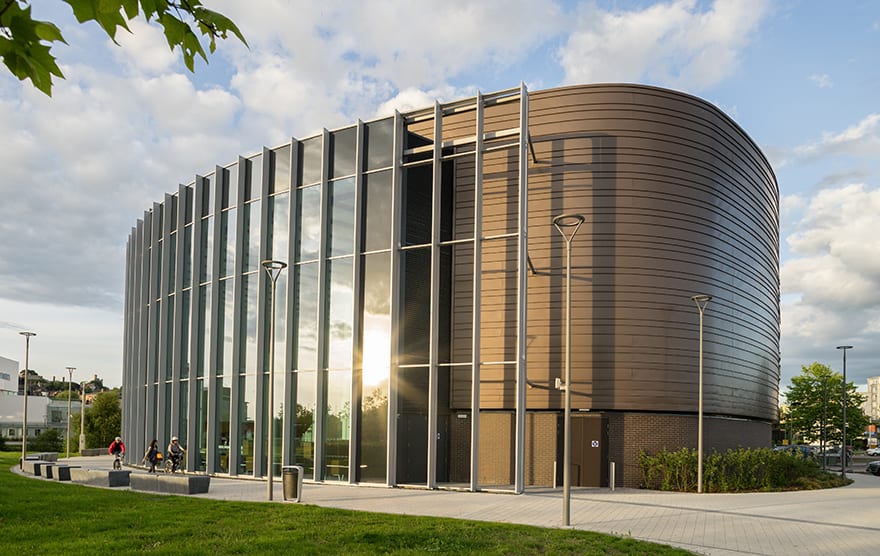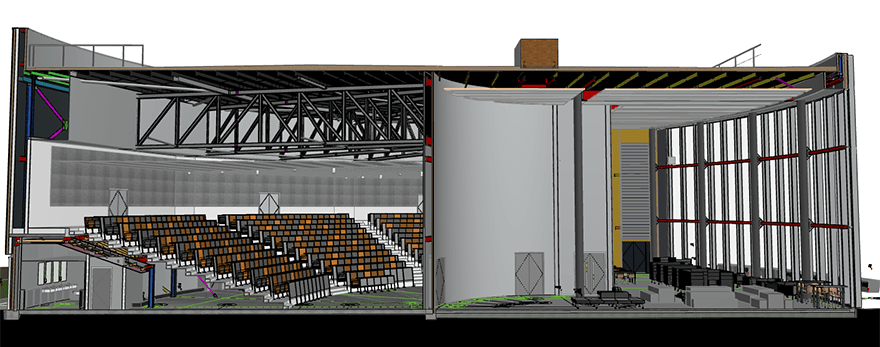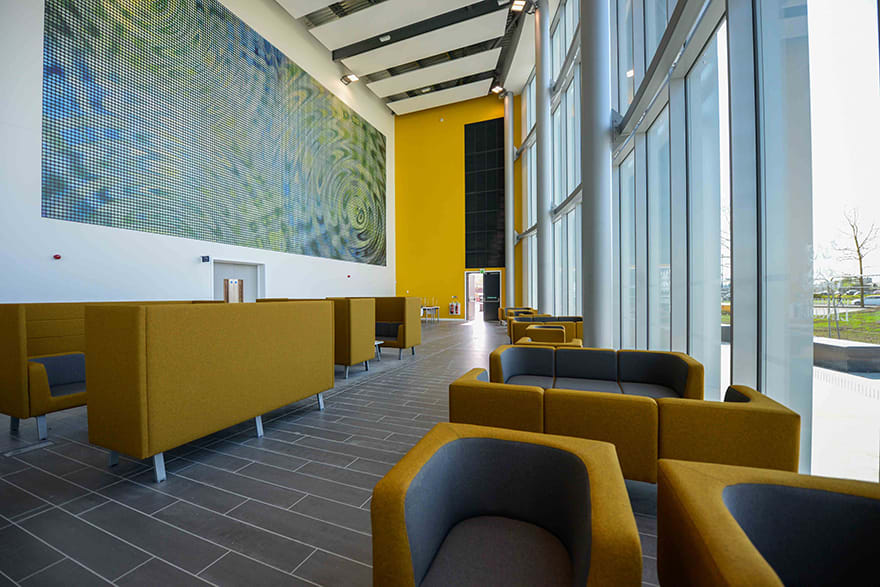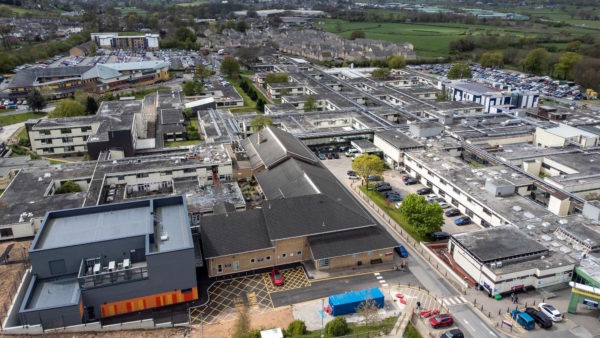- Client: University of Lincoln
- Lead Contractor: Kier and BAM Construction; Architect: maber
- BIM Tools: ARCHICAD, Solibri, BIMx
As part of its ongoing programme to provide excellent subject-specific facilities, the University of Lincoln invested £28m to create the Isaac Newton Building, to house the Schools of Computer Science, Engineering, Mathematics and Physics and to strengthen the university’s growing strategic partnership with Siemens.
The development was divided into two overlapping phases. Phase one was an extension to the existing engineering building, built by contractor Kier. This extra space supports the partnership with Siemens, as well as the addition of Electrical and Electronic Engineering to the School of Engineering’s portfolio.
Phase two created a new building to house the university’s Schools of Computer Science, Mathematics and Physics. Built by BAM Construction, this second phase also included a new 500-seat lecture theatre and a catering facility, enhancing the university’s ability to accommodate large-scale events.
The University of Lincoln selected maber to provide architectural services for the new building. maber worked to very tight timescales and completed the full designs and technical design drawings in under a year. Using ARCHICAD as its main authoring tool and Solibri for clash detection, maber was able to adjust and test the designs very quickly.

The curved building facade features bronze rainscreen cladding
“The university loved Graphisoft’s virtual reality tool BIMx – being able to show the client the walk-throughs was incredibly valuable and helped us to test different concepts quickly,” said maber associate Alex Lipinski.
The university wanted to reflect its top 50 position with a statement design suitable to the prominent location of the building at one of the key approaches to central Lincoln.
With these requirements in mind, maber used ARCHICAD’s curtain walling tool to design a striking curved building facade for the areas closest to the road. This was accentuated with bronze rainscreen cladding, designed to contrast with the powdered aluminium finish of the curtain wall system.
“The curtain walling tool is easy to use, and it’s very quick to get the results you want,” explains Lipinski. “Without it, it would have been days of work to complete that element of the design.”

A cutaway through the 500-seat lecture theatre showing elements of structure
The building location posed a number of design challenges for maber, especially in terms of available space. Each teaching discipline had very specific requirements for specialist areas such as laboratories, workshops, robotics and computer suites all requiring a large amount of electrical services, plumbing and pipework.
Lipinski explains: “We had to design within the constraints of the viewing corridor for Lincoln cathedral just 500m away. In addition, we needed to connect an existing building over the top of a culvert on a tightly constrained site. Meanwhile, all the building work was carried out while students were still on campus attending the university.”
Level 2 BIM was mandated on the project, with the contractor BAM providing information management services. Consultants employed on the project used a variety of different BIM authoring tools so data was shared via open standard IFC (Industry Foundation Class).
Due to the amount of different services required for the building, precise coordination was essential. maber shared IFC data with the other main contractors, including electrical and mechanical services, and structural engineers.

The main atrium
“With ARCHICAD, there is no barrier to collaboration when contractors are using different platforms. It takes a little time to set everything up, but once the initial coordination document is shared and the parameters are agreed, everyone is working from the same reference point,” says Lipinski.
“Being able to link in models from other consultants and subcontractors was very useful during design and construction as we were able to pick up on coordination issues quickly without having to refer to the drawings,” says Lipinski. “This helped to speed up our clash detection processes; it would have taken at least 10 times longer without Solibri as we had at least 50 drawings to compare per consultant.
“The Isaac Newton Building is a very complex building and structure. With clash detection, we could immediately see if steels were in the wrong place for example. Without Solibri, it would have been very easy to miss clashes on the drawings.
“We could also quickly and easily check mechanical and engineering elements for the whole model, ensuring complex details for elements such as the acoustic ceilings were correct.”

ARCHICAD model showing view of the main entrance looking east across the Delph Pond
Just a couple months before handover the University of Lincoln asked for COBie (Construction Operations Building information exchange) data for the new building, to enable it to manage its new assets more effectively. Despite the short notice maber was able to deliver its portion of the COBie data using the IFC management systems within ARCHICAD.
“Fortunately, we were able to access the COBie data directly from ARCHICAD. COBie is taken directly from the IFC files and we have tools within ARCHICAD for importing and exporting COBie,” says Lipinski.
“The advantage of ARCHICAD is that every element is numbered so it was relatively straightforward to produce a schedule and fill in the blanks. Without ARCHICAD and the IFC data already in place, it would have been weeks of work to produce the required COBie information for the client.”
To aid the university’s facilities management, maber provided data about the rooms including sizes, zones and classifications while BAM provided information about the components that need maintaining. BAM validated the COBie data before delivering it to the client.
The building was completed in spring 2017 and is now operational and enjoyed by students, visitors and the inhabitants of Lincoln.
The university loved Graphisoft’s virtual reality tool BIMx – being able to show the client the walk-throughs was incredibly valuable and helped us to test different concepts quickly.– Alex Lipinski, maber













